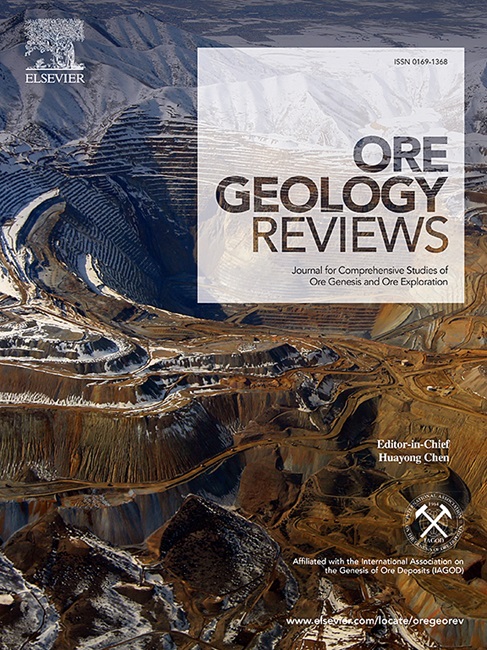华北克拉通北缘花石地区马迭侵入体的年龄和岩石成因:对岩浆演化和铌钽成矿的影响
IF 3.2
2区 地球科学
Q1 GEOLOGY
引用次数: 0
摘要
尽管稀土元素(REEs)和稀有金属的成矿与花岗岩岩浆的极端分馏密切相关,但许多花岗岩型铌钽矿床的成矿侵入体都经历了流体-熔体相互作用。然而,人们对流体-熔体相互作用影响成矿作用的确切机制仍然知之甚少。本研究利用华北克拉通(NNCC)北缘新发现的花石矿床的数据,研究了具有铌钽矿化的高分馏花岗岩中的流体-熔体相互作用问题。华石铌-钽-铷-锂矿床赋存于马迭尔侵入体中,由两种连续演化的岩性组成,即下部的中细粒花岗岩(MGG)和顶部的碱长花岗岩(AG)。采用 LA-ICP-MS 铌铁矿 U-Pb 测定法测定了中细粒花岗岩和 AG 的年龄,结果分别为 182.9 ± 1.7 Ma 和 184.7 ± 1.3 Ma。马迪侵入体的SiO2、Al2O3和总碱含量较高,而CaO、MgO、MnO和TFe2O3含量较低,Al2O3/(CaO + Na2O + K2O)(A/CNK)值较高,因此被归类为具有高K钙碱亲和性的高铝花岗岩。此外,该侵入体还显示出 Rb、U、Th 和 Nb 的富集,同时 Sr、Ba、Ti、Eu 和 P 的显著贫化,具有明显的 REEs 四元效应。利用电子探针显微分析法(EPMA)对马迪侵入体中的云母和长石矿物进行的研究表明,云母主要是黝帘石,而斜长石属于白云母。总之,马迪侵入体表现出高度的I型分馏花岗岩亲和性。该侵入体的极端分馏、强烈的流体-熔体相互作用以及热液蚀变作用促成了花石矿床的形成。本文章由计算机程序翻译,如有差异,请以英文原文为准。

Age and petrogenesis of the Madi intrusion in the Huashi area, northern margin of the North China Craton: Implications for magma evolution and Nb–Ta mineralization
Although the mineralization of rare earth elements (REEs) and rare metals is intimately associated with the extreme fractionation of granitic magmas, the metallogenic intrusions of many granite-hosted Nb–Ta deposits have undergone fluid–melt interaction. Nevertheless, the precise mechanisms by which fluid–melt interaction influences mineralization remain poorly understood. The present investigation examines the issues of the fluid–melt interaction in highly fractionated granites with Nb–Ta mineralization, utilizing data from the newfound Huashi deposit in the northern margin of the North China Craton (NNCC). The Huashi Nb–Ta–Rb–Li deposit hosted in the Madi intrusion consists of two lithologies that have evolved continuously, namely medium–fine grained granite (MGG) in the lower section and alkali-feldspar granite (AG) at the top. The ages of the MGG and AG were determined using LA–ICP–MS columbite U–Pb dating, yielding values of 182.9 ± 1.7 Ma and 184.7 ± 1.3 Ma, respectively. The Madi intrusion has high SiO2, Al2O3, and total alkali contents, along with low CaO, MgO, MnO, and TFe2O3 contents and high Al2O3 / (CaO + Na2O + K2O) (A/CNK) values, classifying it as highly peraluminous granite with a high-K calc-alkaline affinity. Additionally, the intrusion also exhibits enrichment in Rb, U, Th, and Nb alongside significant depletion in Sr, Ba, Ti, Eu, and P, with a noticeable tetrad effect of REEs. The investigation of mica and feldspar minerals in the Madi intrusion using electron probe microanalysis (EPMA) indicates that the mica is mainly zinnwaldite, while the plagioclase belongs to albite. In summary, the Madi intrusion exhibits a highly I-type fractionated granite affinity. The extreme fractionation, intense fluid–melt interaction, and hydrothermal alteration of the intrusion contribute to the formation of the Huashi deposit.
求助全文
通过发布文献求助,成功后即可免费获取论文全文。
去求助
来源期刊

Ore Geology Reviews
地学-地质学
CiteScore
6.50
自引率
27.30%
发文量
546
审稿时长
22.9 weeks
期刊介绍:
Ore Geology Reviews aims to familiarize all earth scientists with recent advances in a number of interconnected disciplines related to the study of, and search for, ore deposits. The reviews range from brief to longer contributions, but the journal preferentially publishes manuscripts that fill the niche between the commonly shorter journal articles and the comprehensive book coverages, and thus has a special appeal to many authors and readers.
 求助内容:
求助内容: 应助结果提醒方式:
应助结果提醒方式:


